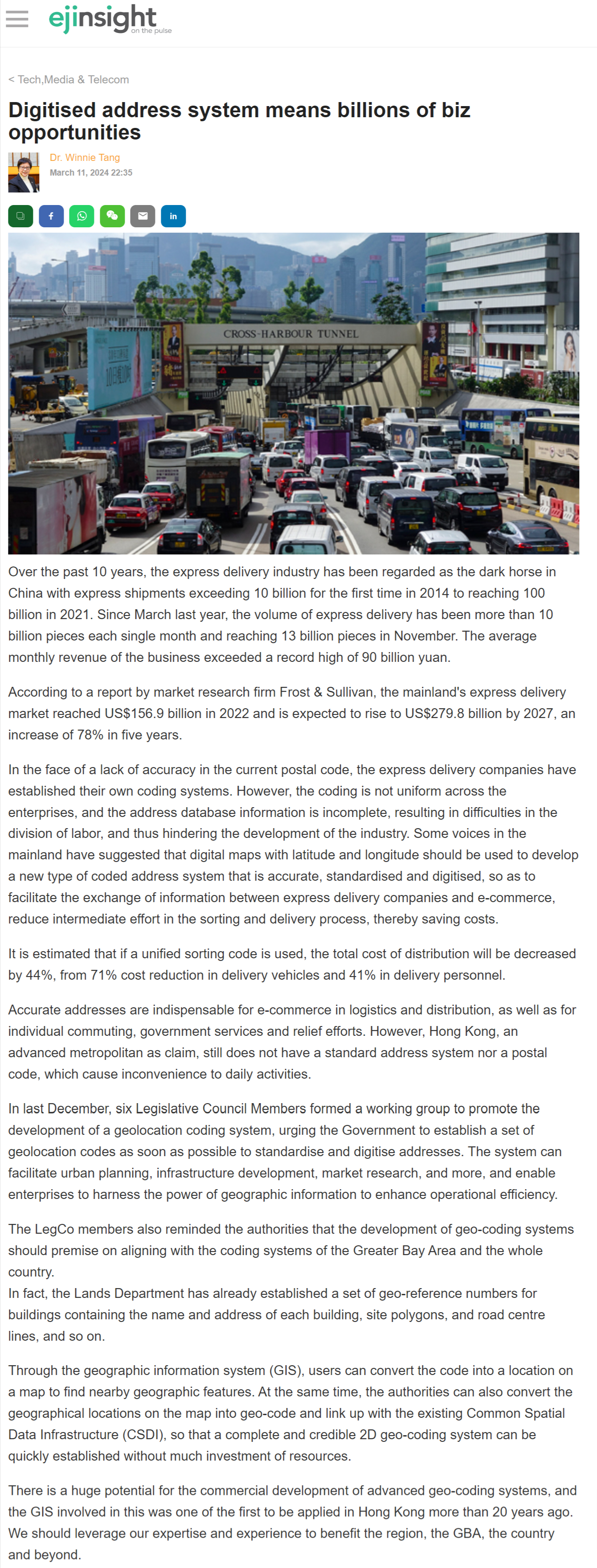網上版請按此

Digitised address system means billions of biz opportunities
Over the past 10 years, the express delivery industry has been regarded as the dark horse in China with express shipments exceeding 10 billion for the first time in 2014 to reaching 100 billion in 2021. Since March last year, the volume of express delivery has been more than 10 billion pieces each single month and reaching 13 billion pieces in November. The average monthly revenue of the business exceeded a record high of 90 billion yuan.
According to a report by market research firm Frost & Sullivan, the mainland's express delivery market reached US$156.9 billion in 2022 and is expected to rise to US$279.8 billion by 2027, an increase of 78% in five years.
In the face of a lack of accuracy in the current postal code, the express delivery companies have established their own coding systems. However, the coding is not uniform across the enterprises, and the address database information is incomplete, resulting in difficulties in the division of labor, and thus hindering the development of the industry. Some voices in the mainland have suggested that digital maps with latitude and longitude should be used to develop a new type of coded address system that is accurate, standardised and digitised, so as to facilitate the exchange of information between express delivery companies and e-commerce, reduce intermediate effort in the sorting and delivery process, thereby saving costs.
It is estimated that if a unified sorting code is used, the total cost of distribution will be decreased by 44%, from 71% cost reduction in delivery vehicles and 41% in delivery personnel.
Accurate addresses are indispensable for e-commerce in logistics and distribution, as well as for individual commuting, government services and relief efforts. However, Hong Kong, an advanced metropolitan as claim, still does not have a standard address system nor a postal code, which cause inconvenience to daily activities.
In last December, six Legislative Council Members formed a working group to promote the development of a geolocation coding system, urging the Government to establish a set of geolocation codes as soon as possible to standardise and digitise addresses. The system can facilitate urban planning, infrastructure development, market research, and more, and enable enterprises to harness the power of geographic information to enhance operational efficiency.
The LegCo members also reminded the authorities that the development of geo-coding systems should premise on aligning with the coding systems of the Greater Bay Area and the whole country.
In fact, the Lands Department has already established a set of geo-reference numbers for buildings containing the name and address of each building, site polygons, and road centre lines, and so on.
Through the geographic information system (GIS), users can convert the code into a location on a map to find nearby geographic features. At the same time, the authorities can also convert the geographical locations on the map into geo-code and link up with the existing Common Spatial Data Infrastructure (CSDI), so that a complete and credible 2D geo-coding system can be quickly established without much investment of resources.
There is a huge potential for the commercial development of advanced geo-coding systems, and the GIS involved in this was one of the first to be applied in Hong Kong more than 20 years ago. We should leverage our expertise and experience to benefit the region, the GBA, the country and beyond.
Dr. Winnie Tang
Adjunct Professor, Department of Computer Science, Faculty of Engineering; Department of Geography, Faculty of Social Sciences; and Faculty of Architecture, The University of Hong Kong